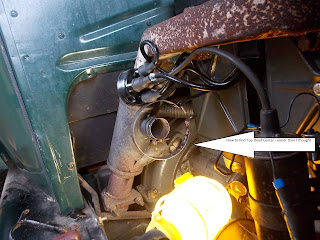Born in Buffalo New York
Of all the things I
have found out about the truck, I think the neatest thing was this:
One common misconception with our
old cars is that there was a VIN number used on early Chevrolets. Chevrolet did
not use a VIN (Vehicle Identification Number) until the mid-1950's. There are
no stamped serial numbers on the frame so engine serial numbers were commonly
used by Motor Vehicle Departments for registration purposes. A plate was used
that gives detailed information about the vehicle but it was not generally used
for vehicle identification.
Early Chevrolet cars & trucks
used Car Number Plates to identify where the vehicle was made, which month it
was made, show the series and the number of the vehicle as it came off the
assembly line. Most early wood-bodied models had this plate
nailed into the seat frame or the floor on the passenger side. For
this reason, they are often missing. As for the ID
plate, it might be nailed on the passenger side of the wood box that
encircles the gas tank and also is the seat bottom support. When you open the
passenger door, the ID plate should be in plain sight.
The ID plate reads
"Manufactured by Chevrolet Motor Company
division of General Motor Corporation.”
"Manufactured by Chevrolet Motor Company
division of General Motor Corporation.”
Model CAPITAL
CAR NUMBER 12 LO 3625
Year
|
Model/
Series |
Wheel Base (Inches)
|
Size
|
1927
|
LM
|
1-ton - trade name "Capital"
|
|
1928
|
LO
LP |
1-ton (early) - trade name "Capital"
1-ton (late) - trade name "Capital" Chevrolet changed Series designation when front wheel brakes were added mid-year. |
|
1929
|
AC
LQ |
107
131 |
1/2-ton
1.5-ton |
1930
|
AD
LR LS |
107
131 131 |
1/2-ton
1.5-ton (1st Half) 1.5-ton (2nd Half) |
Plants of Manufacture
1. Flint, Michigan
2. Tarrytown, New York
3. St. Louis, Missouri
5. Kansas City, Missouri
6. Oakland, California
8. Atlanta, Georgia
9. Norwood, Ohio
12. Buffalo, New York
14. Baltimore, Maryland
20. Van Nuys, California
21. Janesville, Wisconsin
YEAR
|
SERIES
|
MODEL
|
1925
|
V
|
Superior
|
1926
|
K
|
Superior
|
1927
|
AA
|
Capitol
|
1928
|
AB
|
National
|
1929
|
AC
|
International
|
1930
|
AD
|
Universal
|
1931
|
AE
|
Independence
|
1932
|
BA
|
Confederate
|
1933
|
CA
|
Eagle
|
1933-36
|
Car
& Truck
|
Master
|
1933-36
|
Std Car
|
Standard
|
1937-39
|
Car
& Truck
|
Master
|
1937-39
|
Deluxe
Car
|
Deluxe
Master
|
Car number breakdown
12 means Buffalo, New York
LO means – 1 ton (early)
The numbers "03"
indicates the month that the vehicle was manufactured - March of 1932. If the
number was "11", that would indicate that the vehicle was
manufactured in November of 1931. This part of the serial number was not used
until the 1932 production (model year), therefore, 1931 and earlier
models will not have these two numbers. In 1932, there were two
different Car Number Plates used. All 1932 models had a 2-digit month of
manufacture added to the number. Early production vehicles used
"Car Number" on the plate, just like the 1931 models.
Later production models used a new plate that had a longer field for the
number. In order to make room for the longer number, the words "Car
Number" were shortened to "Car No". From 1932 and later "Car
No." was used.
Chevrolet »
Series LM / LO / LP (1927 - 1929)
With the introduction of a new Chevrolet Capitol Series AA
car, a new truck series was also brought out. The new series known as the LM. Basically,
these trucks were little different than the R or X series, though the radiator
shell followed the lines of the Capitol autos. Chevrolet offered its own panel
body with new design till 1928, again leaving this field wide open to the
after-market body builders. The Series LM chassis are available with only
fenders, running boards, radiator and hood; as chassis and cowl units, or as
chassis, cowl and closed cabin. The 1-ton chassis continued to use 124-inch
wheelbase. The LO series replaced the LM series in 1928, but then the LO was
succeeded at mid-year by the LP Series. Actually, the LO series was almost
identical to the LM series, and can be considered a transitional vehicle.
However, the LP series offered many mechanical improvements over previous truck
models. There were a new 4-speed transmission as standard equipment (a lighter
version of a 4-speed transmission was an option before) and mechanical 4-wheel
brakes (LP is the first Chevrolet truck was equipped with front brakes). The
4-cylinder engine developed 35 hp.








That's very cool and interesting - always good to have the history to the car and where, when it was made.
ReplyDelete